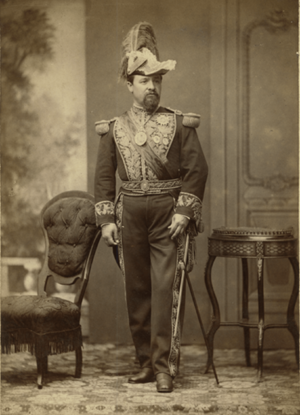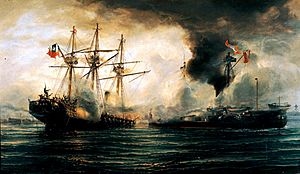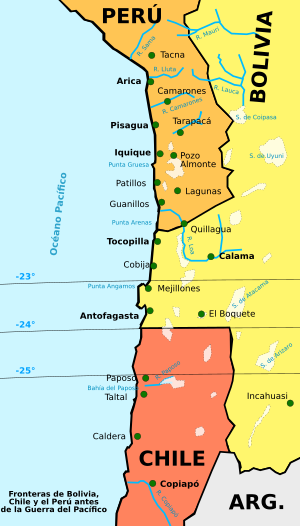Hilarión Daza facts for kids
Quick facts for kids
Hilarión Daza
|
|
|---|---|
 |
|
| 19th President of Bolivia | |
| In office 4 May 1876 – 28 December 1879 |
|
| Preceded by | Tomás Frías |
| Succeeded by | Pedro José de Guerra (acting) Uladislao Silva (President of the Junta) Narciso Campero (provisional) |
| Minister of War | |
| In office 13 May 1874 – 14 February 1876 |
|
| President | Tomás Frías |
| Preceded by | Ildefonso Sanjinés |
| Succeeded by | Eliodoro Camacho |
| Personal details | |
| Born |
Hilarión Daza Groselle
14 January 1840 Sucre, Bolivia |
| Died | 27 February 1894 (aged 54) Uyuni, Bolivia |
| Cause of death | Assassination |
| Spouse | Benita Gutiérrez |
| Children | Raquel Daza Gutiérrez |
| Parents | Marcos Groselle Juana Daza |
| Signature |  |
| Military service | |
| Branch/service | Bolivian Army |
| Rank | General |
Hilarión Daza Groselle (born January 14, 1840 – died February 27, 1894) was a Bolivian army officer. He became the 19th president of Bolivia, serving from 1876 to 1879. During his time as president, the famous War of the Pacific began. This war had a very bad impact on Bolivia.
Contents
Hilarión Daza's Early Life
Growing Up in Bolivia
Daza was born in the city of Sucre, Bolivia, on January 14, 1840. His father, Marcos Groselle, was from Italy. His mother, Juana Daza, was of mixed heritage. Hilarión changed his last name to his mother's. This helped him fit in better with Bolivian society.
He joined the military when he was very young, in the 1850s. He was very good at being a soldier. People saw him as a strong and skilled leader.
Military and Political Career
At first, Daza supported President Mariano Melgarejo (1864-1871). But in 1870, he started his own political journey. He turned against Melgarejo. He became important under Agustín Morales, who was president from 1871 to 1872. Under Morales, Daza took charge of the famous Colorados Battalion.
The Colorados were special soldiers. They were meant to protect the President of Bolivia. They were like bodyguards but also highly trained fighters. They were known for being very skilled and feared. The Colorados stayed loyal to Daza. They helped him gain more power.
After President Morales was killed in November 1872, Daza briefly took charge. He then gave power to Tomás Frías. Frías was the rightful leader at the time. Later, Daza supported the government of Adolfo Ballivián (1873-1874). When Ballivián died, Daza supported Frías again. Frías became president after Ballivián's sudden death. During Frías's presidency, Daza served as the Minister of War.
Daza's Time as President
Becoming President and Early Challenges
In 1876, Daza became an army general. He then rebelled against President Frías and took over. He became the Provisional President. In 1878, the Constituent Assembly confirmed him as president. With his Colorados Battalion, he ruled with a strong hand. He stopped any opposition to his government. Daza hoped to get support from Bolivian citizens. This would help him against challenges from within the country.
Growing Problems with Chile
When Daza became president, he wanted Bolivia to control the Litoral province. This was a coastal area that was not very populated. By the late 1870s, many Chileans lived there. It was easier for Chileans to reach this area than for Bolivians from the highlands. Because of this, Chile started to claim the region as its own. This became a bigger issue when rich deposits of guano (bird droppings used as fertilizer) were found near the Bolivian port of Mejillones. In 1878, Bolivia had a big earthquake. Then, a severe drought caused a famine.
The problem with Chile started because Chile had a lot of influence on the Bolivian coast. This area was rich in guano and saltpeter. A company called Compañía de Salitres y Ferrocarril de Antofagasta had many Chilean owners. Daza, once in power, started policies that were against Chile. Chileans living in Antofagasta complained about bad treatment from Bolivian officials.
The Saltpeter Tax
In 1873, Bolivia signed a deal with the Compañía de Salitres y Ferrocarril de Antofagasta. This deal was not yet official by 1878. Bolivia's constitution said that deals about natural resources needed approval from Congress. So, on February 14, 1878, the Bolivian National Constituent Assembly approved a law. It said the company had to pay a tax of 10 cents for each unit of saltpeter it exported.
Chile said this tax broke a treaty from 1874. That treaty said Bolivia could not raise taxes for 25 years on "Chilean people, industries, and money" in that area. Bolivia argued that the company was not a "Chilean citizen" but a business. So, it had to follow Bolivian laws. The Chilean owners of the company refused to pay the tax. They asked the Chilean government for help. Chile promised to support the company.
The Chilean government saw this as a problem between two countries. This started a diplomatic fight between Bolivia and Chile. It quickly got worse because Daza's government was not good at diplomacy. Peru tried to help solve the problem. They sent an ambassador to Chile to try and stop a war. The treaty said that any disagreements should be settled by an independent decision-maker.
Chile Occupies Antofagasta
On November 17, 1878, Bolivia ordered its officials to collect the 10-cent tax. This was an attempt to fix Bolivia's serious money problems. This event became a reason for war. On February 1, 1879, Bolivia canceled the company's contract. They decided to take back the saltpeter fields. They planned to sell the company's property to collect the unpaid taxes. This sale was set for February 14, 1879. Daza did not think Chile would fight back.
But Chile occupied Antofagasta on February 14, 1879, stopping the sale. Daza said this invasion was a reason for war and declared war on Chile. Bolivia had a secret treaty with Peru from 1873. Peru had promised to help Bolivia if there was a conflict with Chile. Chile declared war on Bolivia on March 5, 1879. Chile then took control of the Bolivian coast. They also claimed old territories between those areas.
The War of the Pacific
First Steps of the War

Chilean troops quickly took over the entire Bolivian coastline. The Bolivian Army did not fight back. A common story says that Daza was celebrating his birthday when Chile invaded Antofagasta. It was during carnival, and some say Daza hid the news of the invasion so the parties would not stop. However, this story has never been proven.
Finally, on February 28, the news of the Chilean invasion reached Bolivia. On March 1, Daza announced that Bolivia was cutting ties with Chile. He also said that properties of Chilean citizens would be taken by force. At the same time, he asked Peru for help, based on their Defensive Alliance Treaty from 1873.
Bolivia Declares War and Peru Joins
Peru's government quickly sent a diplomat to Chile to try and make peace. But while these talks were happening, Daza declared war on Chile on March 14. He seemed to want the talks to fail and force Peru to join the fight.
On March 23, Bolivian and Chilean forces fought in the Battle of Calama. The Chileans won. Finally, on April 5, Chile declared war on Peru. Peru had refused to stay neutral in the conflict. As the war went on, the Chileans slowly pushed the combined Bolivian and Peruvian forces towards defeat. Because of this, Daza secretly talked with Chilean agents. He wanted Bolivia to leave the war and let Peru fight alone. In return, Bolivia would get land as payment for losing its coast. These talks never worked out because Bolivia's congress did not approve.
Daza's Downfall
On April 17, 1879, Daza stepped down as head of state. He wanted to lead the army himself. He led his troops to Tacna. After Chile landed troops in Pisagua, Daza marched south. He wanted to support the Peruvian Army in Iquique. After a short stay in Arica, he kept marching. But after three days of marching through the Camarones ravine, he told Peruvian President Mariano Ignacio Prado that his troops refused to go on. They said the desert conditions were too harsh. They decided to go back to Arica. Daza's message to Prado on November 16 said, "Desert overwhelms, army refuses to move forward." This decision greatly changed the war. It left Peru almost alone in the fight.
Meanwhile, the Peruvian army in Iquique, led by General Juan Buendía, decided to move inland. Buendía trusted that Daza's forces would arrive to break the Chilean lines. But the news of Daza's retreat greatly lowered the morale of the Peruvian troops. They suffered a big defeat in San Francisco on November 19. Daza returned to Arica. There, he learned he had been removed as President of Bolivia on December 28. This happened after a military takeover. People were very unhappy with how the war was going. Daza then moved to Arequipa, where he waited for his family. After they joined him, he left for Europe. He had a lot of money, as he had taken some of Bolivia's treasury. He settled in Paris, France. In Bolivia, General Narciso Campero replaced Daza. Campero had played a key role in removing Daza. A temporary government was then set up, led by Uladislao Silva. This government ruled until Campero was elected as provisional president.
Later Life and Death
Return to Bolivia and Assassination
After 15 years in France, Daza asked the Bolivian president, Mariano Baptista, for permission to return home in 1893. He wanted to defend himself against accusations made in the Legislative Congress. In 1894, Daza arrived at the port of Antofagasta (which used to be Bolivian territory). From there, he went to Uyuni. He hoped to reach the city of La Paz. However, his guards killed him when he arrived at the Uyuni railway station.
What People Say About Daza
Since the early 2000s, some people have tried to clear Daza's name. They try to explain his murder with many theories. They say he was going to reveal secrets about Narciso Campero and others in the Bolivian Congress. Some writers believe that Narciso Campero did not order his troops to fight in Atacama in 1879. They think Campero was working with mining businessmen like Aniceto Arce. These businessmen had business interests with Chilean investors on the Pacific coast. This area was taken by Chile in March 1879. However, none of these claims have ever been proven.
Personal Life
Hilarión Daza married Doña Benita Gutiérrez in La Paz on October 12, 1872. The witnesses at their wedding were Agustín Morales and Casimiro Corral. Corral was Bolivia's Minister of Foreign Affairs at the time. They had one child, a daughter named Doña Raquel Daza y Gutiérrez.
See also
 In Spanish: Hilarión Daza para niños
In Spanish: Hilarión Daza para niños




